
Black-figure pottery painting, also known as the black-figure style or black-figure ceramic, is one of the styles of painting on antique Greek vases. It was especially common between the 7th and 5th centuries BCE, although there are specimens dating as late as the 2nd century BCE. Stylistically it can be distinguished from the preceding orientalizing period and the subsequent red-figure pottery style.

Exekias was an ancient Greek vase painter and potter who was active in Athens between roughly 545 BC and 530 BC. Exekias worked mainly in the black-figure technique, which involved the painting of scenes using a clay slip that fired to black, with details created through incision. Exekias is regarded by art historians as an artistic visionary whose masterful use of incision and psychologically sensitive compositions mark him as one of the greatest of all Attic vase painters. The Andokides painter and the Lysippides Painter are thought to have been students of Exekias.

Red-figure vase painting is one of the most important styles of figural Greek vase painting.

Sophilos was an Attic potter and vase painter in the black-figure style. Sophilos is the oldest Attic vase painter so far to be known by his true name. Fragments of two wine basins (dinoi) in Athens are signed by him, indicating that he both potted and painted them. In total, 37 vessels are ascribed to him, mostly amphorae, dinoi, kraters, as well as three pinakes. Apart from his work for the domestic market, he was also one of the masters of major significance in the process of supplanting the dominance of Corinthian vase painting in the markets of Etruria, and Southern Italy, the most important export area for Greek vases. His works were exported as far as the Black Sea region, Syria and Egypt (Naukratis).

Euphronios was an ancient Greek vase painter and potter, active in Athens in the late 6th and early 5th centuries BC. As part of the so-called "Pioneer Group,", Euphronios was one of the most important artists of the red-figure technique. His works place him at the transition from Late Archaic to Early Classical art, and he is one of the first known artists in history to have signed his work.
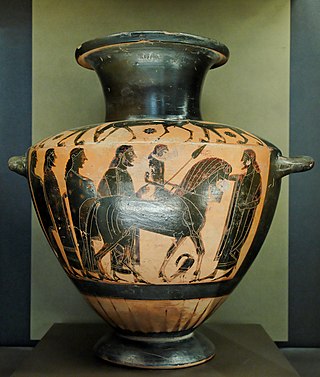
Lydos was an Attic vase painter in the black-figure style. Active between about 560 and 540 BC, he was the main representative of the '’’Lydos Group’’’. His signature, ό Λυδός, ho Lydos ", inscribed on two vases, is informative regarding the cultural background of the artist. Either he immigrated to Athens from the Lydian empire of King Kroisos, or he was born in Athens as the son of Lydian parents. In any case, he learned his trade in Athens.
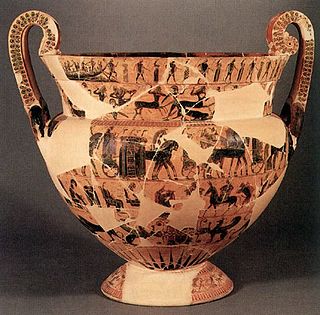
The François Vase is a large Attic volute krater decorated in the black-figure style. It stands at 66 cm in height and was inspired by earlier bronze vases. It was used for wine. A milestone in the development of ancient Greek pottery due to the drawing style used as well as the combination of related stories depicted in the numerous friezes, it is dated to circa 570/560 BCE. The François Vase was discovered in 1844 in Chiusi where an Etruscan tomb in the necropolis of Fonte Rotella was found located in central Italy. It was named after its discoverer Alessandro François, and is now in the Museo Archeologico in Florence. It remains uncertain whether the krater was used in Greece or in Etruria, and whether the handles were broken and repaired in Greece or in Etruria. The François Vase may have been made for a symposium given by a member of an aristocratic family in Solonian Athens, then broken and, after being carefully repaired, sent to Etruria, perhaps as an instance of elite-gift exchange. It bears the inscriptions Ergotimos mepoiesen and Kleitias megraphsen, meaning 'Ergotimos made me' and 'Kleitias painted me'. It depicts 270 figures, 121 of which have accompanying inscriptions. It is highly unusual for so many to be identifiable: the scenes depicted represent a number of mythological themes. In 1900 the vase was smashed into 638 pieces by a museum guard by hurling a wooden stool against the protective glass. It was later restored by Pietro Zei in 1902, followed by a second reconstruction in 1973 incorporating previously missing pieces.
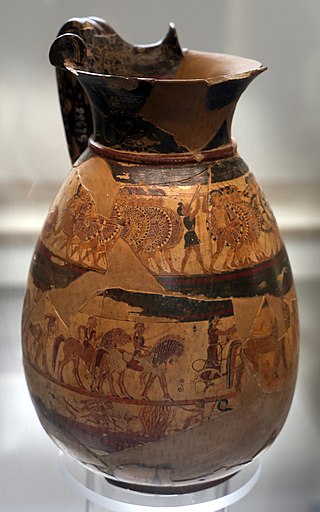
The Chigi vase is a Proto-Corinthian olpe, or pitcher, that is the name vase of the Chigi Painter. It was found in an Etruscan tomb at Monte Aguzzo, near Veio, on Prince Mario Chigi’s estate in 1881. The vase has been variously assigned to the middle and late Proto-Corinthian periods and given a date of ca. 650–640 BC; it is now in the National Etruscan Museum, Villa Giulia, Rome.

Dodwell Painter was an ancient Corinthian vase painter in the black-figure style whose real name is rather unknown. He was active during the Middle and Late Corinthian periods (c. 600–550 BC) and his works dates back to 580 to 570 BC.
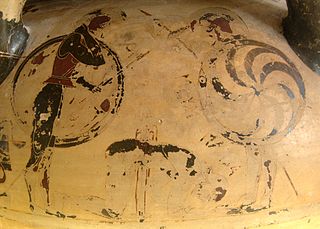
Eurytios Krater is the name given to a famous Early Corinthian column krater. The Eurytios krater is dated to about 600 BC. The vase combined the possibilities of the recently invented or introduced styles of black-figure vase painting and polychrome painting in terms of shape and decoration of the vase with a particularly high quality of artisanship.

The Tydeus Painter was an ancient Greek vase painter working in the Corinthian black-figure style. His real name is unknown. He was active during the Late Corinthian phase ; his works are dated to about 560 BC.
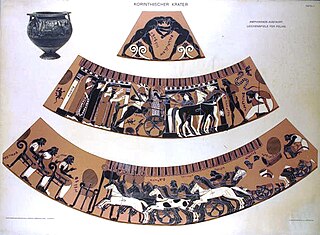
The Amphiaraos krater is a Late Corinthian red-ground column krater. It is considered the masterpiece of the Amphiaraos Painter and one of the major specimens of the red-ground vase painting of Corinth.
The Comast Group was a group of Attic vase painters in the black-figure style. The works of its members are dated to between 585 and 570/560 BC. The artists of the Komast Group are seen as the successors of the Gorgon Painter. Its most important representatives were the KX Painter and the slightly later KY Painter. They painted vases shapes that had been newly introduced to Athens or that had not previously been painted. Especially commonly painted by them were '’kothon’’ and lekanis. From Corinth, then still the centre of Greek vase painting, they adopted the Komast cup and the skyphos (known as kotyle. The KY Painter introduced the column krater. Also popular at the time was the kantharos. The group adopted the Corinthian habit of depicting komasts, after which the group is named. It provided the group’s most commonly painted motif. The komast scenes permit Attic artists for the first time to reach the artistic levels of middle-ranking Corinthian vases. While the older KX Painter still mostly painted animals and only the occasional komast scene, the komos became a standard motif for the KY painter and further inferior successors. It is not clear to what extent the painters of the group really cooperated. It is possible that they all worked in the same workshop. The group influenced later Attic vase painters, including the Heidelberg Painter. Works by the Komast Group were not only found in Attica, but appear to have been exported widely. Vases and fragments have been found at many sites, including Naukratis, Rhodes, Central Italy, Taras, and even Corinth.

The C Painter was one of the most important Attic black-figure vase painters. His works date to circa 575–550 BC. His conventional name was allocated by the archaeologist John Beazley. The C stands for "Corinthianising", a reference to the strong influence of Corinthian vase painting on the artist. He was successor to the Comast Group and used the relatively old-fashioned range of vessel shapes preferred by that group, including lekanis, tripod kothon and skyphos. In contrast, he also painted quite innovative lekythoi with pronounced shoulders, although the more conservative Deinaeira type was still in use by some workshops at his time. The C Painter was the first Attic vase painter to paint cups without an offset lip, the Merrythought cup.

The Tyrrhenian amphora is a specific shape of Attic black-figure neck amphora. Tyrrhenian amphorae were only produced during a short period, about 565 to 550 BC. They are ovoid in shape and bear striking decorations. The handle is usually decorated with a lotus-palmette cross or vegetal tendrils. It always terminates in a red-painted ridge. The vase body is painted with several friezes. The uppermost of these, on the shoulder, is usually especially notable. It often contains mythological scenes, but the first erotic motifs in Attic vase painting also occur here. Unique motifs include the sacrifice of Polyxena. Often, the figures are explained by added inscriptions. The other friezes, usually two to three in number, are often decorated with animals. At times, a frieze is replaced with a vegetal band.

Group E was a group of Attic vase painters of the black-figure style. They were active between 560 and 540 BC.

The Lysippides Painter was an Attic vase painter in the black-figure style. He was active around 530 to 510 BC. His conventional name comes from a kalos inscription on a vase in the British Museum attributed to him; his real name is not known.

The Pontic Group is a sub-style of Etruscan black-figure vase painting.
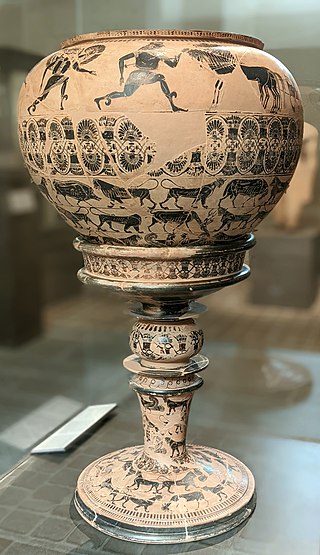
The Dinos of the Gorgon Painter is an important example of ancient Greek pottery, produced at Athens around 580 BC. It entered the Louvre's collection in 1861, with the purchase of Giampietro Campana's collection.
The hoplites were soldiers from Ancient Greece who were usually free citizens. They had a very uniform and distinct appearance; specifically they were armed with a spear (dory) in their right hand and a heavy round shield in their left.


















